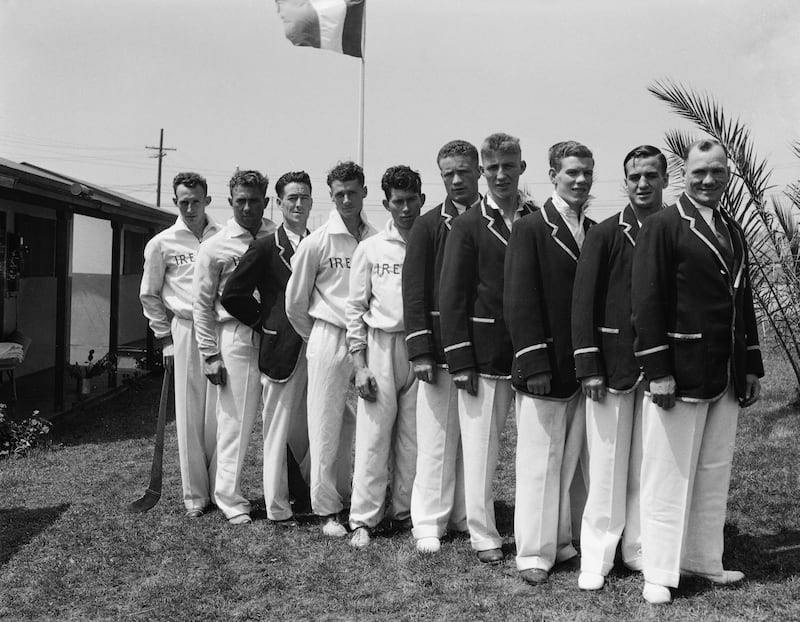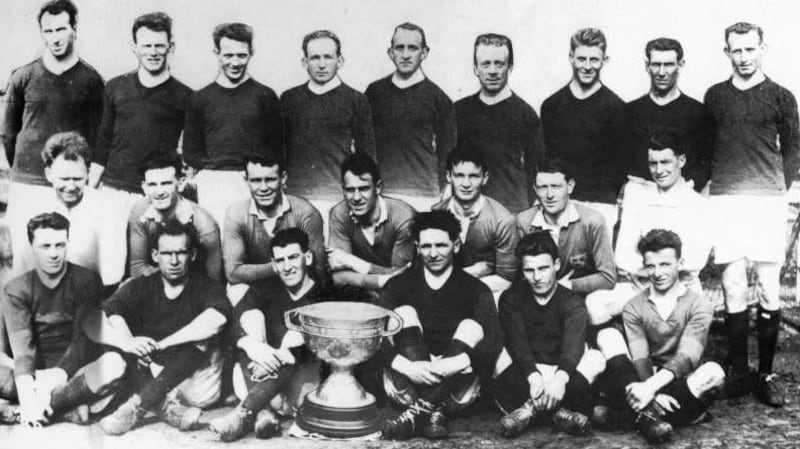This story is part of a series, The Greatest Irish Olympic Stories Never Told, which will run every Saturday in The Irish Times up to the beginning of the 2024 Olympic Games, on Friday, July 26th.
Some of those in the know will tell you that finishing fourth in the Olympics can feel like the loneliest place in all of sport, a sort of no man’s land between what might have been, and what was meant to be.
There is no sure way of knowing how Eamonn Fitzgerald ever felt about it. Such was his unfailing modesty, and a life cut tragically short, that Fitzgerald’s achievement at the 1932 Olympics in Los Angeles, where he finished fourth in the triple jump, was in many parts overlooked. It was also in danger of being entirely forgotten, as his once neglected grave would sadly attest.
Fitzgerald should be remembered as a lot more than just an Irish Olympian. A four-time All-Ireland football winner with Kerry, including in 1932 when they clinched their first four-in-a-row, he was one of the most revered all-round athletes of his time. As superbly conditioned as he was talented, he was also an esteemed language teacher at St Enda’s School in Rathfarnham in Dublin, established in 1908 by Irish nationalist Patrick Pearse.
READ MORE
Yet when Fitzgerald died in June 1958, at the age of 54, after contracting tuberculosis, less than a dozen mourners attended his funeral at Deansgrange Cemetery in Dublin. Despite some later recognition in his native Castlecove, on Kerry’s Iveragh peninsula, his grave was left neglected, overgrown and lost for the best part of four decades. Thanks to an epiphany of sorts, it was rededicated with proper Olympic honours in May 2004.
On that occasion, 46 years after his funeral and 72 years after his fourth-place finish in Los Angeles, then chairman of the Kerry Association in Dublin, Eugene O’Sullivan, said of Fitzgerald: “He was a superstar before the term was known.”
Legendary Kerry broadcaster Weeshie Fogarty, who had played a key role in rediscovering Fitzgerald’s sporting achievements, said: “How Eamonn Fitzgerald combined his brilliant football career with his magnificent achievements in athletics must be rated as one of the all-time great Kerry sporting stories.”
Those 1932 Games were arguably Ireland’s most successful. From the team of only eight who travelled the 5,000-mile distance to Los Angeles – four athletes and four boxers – two brought home gold medals. Dr Pat O’Callaghan famously defended his hammer title and Bob Tisdall won the 400 metre hurdles within an hour of each other, on the afternoon of Monday, August 1st.
Three days later, Fitzgerald, then aged 29, was back inside the 100,000-seater Coliseum having qualified for the triple jump final – then known as the hop, skip and jump – despite nursing an ankle injury sustained in training shortly after arriving in the US. He performed heroically nonetheless, leaping to a lifetime best of 15.01 metres to finish fourth, ultimately denied a place on the podium after Japan’s Chuhei Nambu, a long jump specialist from Sapporo, stunned the entire field with his world-record winning mark of 15.72 metres.
Fitzgerald’s 15.01 metres would have won him the gold medal in seven of the previous nine Olympics. That’s how good he was.

Less than two months later he was back in Croke Park, a non-playing sub on the Kerry team that clinched that fourth successive title when beating Mayo, having started at wing forward in the 1930 and 1931 wins over Monaghan and Kildare respectively. He also won an All-Ireland medal in 1924, with both the Kerry senior and junior teams.
After winning several more Irish athletics titles, including in the high and long jump in 1933, he began dedicating his life entirely to teaching, and some of the Pearse school ideals – Fitzgerald had been briefly imprisoned in Drogheda during the War of Independence for his nationalist activities.
While later studying at UCD, Fitzgerald won the Sigerson Cup three times (1927, 1929, and 1931). In the 1929 final he scored 3-3. He also won Railway Cup honours with Munster in 1931, as well as National League medals with Kerry.
When he first contracted tuberculosis in his early 50s, he broke off a marriage arrangement with his fiancee, from Valentia, and within a year or so of his death in 1958, his grave was entirely abandoned and overgrown.
When he died in 1958, a few fellow teachers removed his remains from his home on Beaumont Avenue in Churchtown, and took them to Deansgrange Cemetery for burial.
Before departing for Los Angeles in 1932, the four Irish athletes spent a two-week training camp in Ballybunion, and Fitzgerald was at that point confident of his Olympic chances. But he reportedly first sustained a minor ankle injury there, before on arrival in the US, and his injury worsened after a training day in Denver. After that, his approach to the Olympics was to rest up as much as possible, and it very nearly worked.
O’Callaghan, meanwhile, who was looking to defend his Olympic hammer title won in Amsterdam four years previously, while the 25-year-old Tisdall was racing the 400 metre hurdles for only the fourth time in his life.
His final was set for 3pm on Monday, August 1st, which happened to be the same time O’Callaghan was in the hammer circle defending his Olympic title. Despite the suitably stacked field, Tisdall produced an astonishing run and won the gold medal in a world record time of 51.7 seconds, despite clattering into the last hurdle (which back in those days ruled out the time for record purposes).
It didn’t matter to Tisdall, who had just won Ireland’s second-ever Olympic medal as an independent state, and minutes later turned his attention to the infield area, where O’Callaghan was having an issue with the length of his spikes. So together they filed them down, before with his final throw of the steel ball and chain, just an inch shy of 177 feet, O’Callaghan landed his second gold medal.
Imagine then if Fitzgerald had managed to win a third Olympic medal, of any colour, and how his place in Irish sporting history might have changed.

Instead his story was largely forgotten, at least until the late Weeshie Fogarty stopped off in the small village of Castlecove while taking part in the Ring Of Kerry Cycle in 2001. He later told the story in his much-loved Radio Kerry programme Terrace Talk:
“I took a walk into the church to have a look around and the sun was streaming in through the beautiful stained-glass windows, and to the left of me one particular window caught my eye, for underneath it was written the words: ‘Erected in memory of Eamonn Fitzgerald.’
“I had vaguely heard of Fitzgerald before, but I didn’t know anything about him. I knew the great Duncan Edwards of Manchester United had a stained-glass window dedicated to him, but I had never before heard of one to an Irish sportsman. This Fitzgerald chap must have been good, I thought.
“I went outside to take a stroll and have a further look around when I saw a stone plaque outside the shop across the road and on it, written in Irish, ‘Eamonn Mac Gearailt, Los Angeles, 1932.’ These were the first two clues hinting at someone remarkable hailing from the village.
“Talking to the locals, Fitzgerald’s achievements were the stuff of legend: brilliant Gaelic footballer, All-Ireland winner, national hop, step and jump champion, he was Castlecove’s most famous son. But as to what happened to him when he went to Dublin to teach, none could say.
“That’s when I enlisted the help of Eugene O’Sullivan, chairman of the Kerry Association in Dublin. Finally, we were able to track the gravestone to Deansgrange cemetery, where it was lying neglected, and Eugene had the unique privilege of being the first Kerryman since Fitzgerald’s funeral in 1958 to lay eyes on the headstone.”
Fitzgerald was born in Behihane, near Castlecove, in 1903, had three brothers and three sisters, and was better known locally as Ned Seán Óg.
The stained-glass window was installed at Castlecove Church in 1984, when the Olympics returned to Los Angeles, part of a small ceremony to mark his sporting feats
He attended Bunaneer National School, and then found himself at school in St Enda’s in Dublin thanks to a wealthy benefactor, the London-born Lady Albinia Lucy Broderick, who arrived in Castlecove to set up a hospital at nearby Westcove.
Despite her family being English Protestant aristocratic, she campaigned passionately for causes as diverse as the reform of nursing, protection and promotion of the Irish language and the freedom of Ireland from British rule
She also took an interest in nationalist activities, involving herself with the Gaelic League, and paying for talented Castlecove children – one of whom was Fitzgerald – to be educated in Dublin. Some of Lady Broderick’s political views impressed on Fitzgerald too, which is why he briefly found himself imprisoned in Drogheda during the War of Independence.
Standing over 6ft, Fitzgerald’s slim build and natural sporting prowess was soon the envy of many, on both the football and athletics field, and yet he maintained his modesty throughout his life. After he died, a small cupboard of his trophies was discovered at St Enda’s, which he’d never desired to put on display.
The stained-glass window was installed at Castlecove Church in 1984, when the Olympics returned to Los Angeles, part of a small ceremony to mark his sporting feats.
Along with the rededicated grave at Deansgrange in 2004, with thanks to Weeshie Fogarty stumbling on his sporting achievements, Fitzgerald has at last found some recognition for his achievements. A true Olympian resting in peace.



















